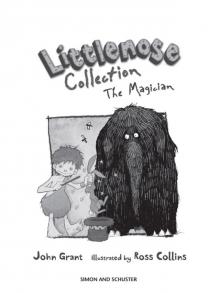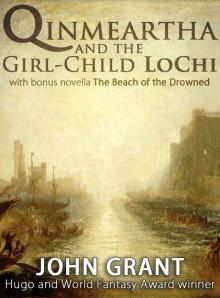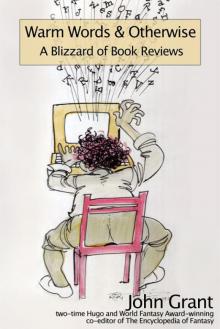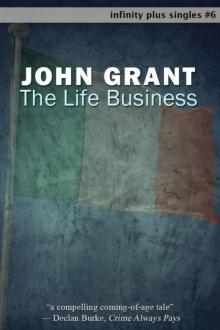- Home
- John Grant
Warm Words & Otherwise: A Blizzard of Book Reviews Page 2
Warm Words & Otherwise: A Blizzard of Book Reviews Read online
Page 2
It would be a credit to Steve Altman and Patrick Merla that they had put together an anthology for the worthy cause of the charities noted above. That they have put together such a fine anthology says more for them.
—Infinity Plus
A Step Beyond
by C.K. Anderson
iPublish, 346 pages, paperback, 2001
The Russian manned expedition to Mars that set off in 2017 was about a year into its voyage when the craft was struck by a small meteoroid and all aboard died. Four years later, in 2022, a new expedition sets off – two expeditions, really, one Russian and the other American, the two craft travelling together and their crews cooperating. The outward trip will take some two years, involving a slingshot around Venus and the deployment there of a robot surface probe.
Not everything goes precisely according to plan. Tensions mount in the Russian craft as its captain develops a major case of the hots for the sole female astronaut involved, who happens to be the wife of the pilot. One of the American team develops acute appendicitis; an emergency operation is performed by his colleagues, but soon after there is a solar flare and he succumbs to a combination of post-operative infection and radiation sickness.
And so on.
The distinction is rarely made between science fiction and fiction written about science for the entertainment of scientists. The reason the distinction is little made is obvious: there's such a huge overlap between the two only marginally different forms that there's hardly ever any point in making it. In such works as Gregory Benford's Timescape (1980), Paul Preuss's Broken Symmetries (1983) and Robert A. Metzger's Picoverse (2002), scientists can find scads of highly entertaining workings-out of ideas from the farther reaches of physical theory; but these novels are also rambunctiously enjoyable as sf.
A Step Beyond, by contrast, is determinedly realistic; paradoxical though it might seem to make this remark about a tale concerning a space expedition, it keeps its feet firmly on the ground. This realism is its great weakness as an sf novel, even at the same time as it is the book's great strength as a work of fiction for those interested in the technology of space exploration. Here you can see worked out very plausibly how things might go for humankind's first manned expedition to Mars, an event that will be exhilaratingly exciting when it happens. The trouble is that, as with virtually any groundbreaking human endeavour, the exciting bits will be possible only because of the 99% of it all that will be, um, well, sort of boring. As example, the first lunar landing was monumentally exciting to watch and vicariously be a part of; but only a few space-exploration junkies (of which I was one) could be bothered to sit through all the banal exchanges between the astronauts and Mission Control on the flights there and back.
In an sf novel we'd be given only the high points of the mission to Mars. In A Step Beyond we're given the whole lot. Paragraphs like this are everywhere:
"Temperature is seven hundred and thirty-seven Kelvin." Satomura was running the fingers of his left hand across the screen and tapping at the keyboard with his right as he read the information out loud. "Surface pressure is ninety-four atmospheres. Wind velocity is one-point-two meters per second."
Satomura is reporting results from the robot probe sent down to Venus, This is actually all pretty exciting stuff for a planetary scientist ... but it's not so thrilling for an sf reader.
There are some identifiable flaws in A Step Beyond. In the first fifty pages or so there's a marked tendency for characters to tell each other at length things they already know:
"Yes," Nelson confirmed. "I've heard that the backroom politics at the Kremlin got quite ugly. Kerimov was threatening to fire the entire Russian Space Agency. At first, he wouldn't even consider a joint mission. He still wanted to demonstrate the greatness of the New Republic by reaching Mars first. But he had lost a lot of credibility with the Volnost disaster. Then there was the tape of the late Commander Titov telling his wife that a joint mission was the safest way to proceed."
Of course, all of the astronauts listening to Nelson know this – there's absolutely no reason for him to tell it to them, and so all that's really going on is a clumsy infodump.
Despite such quibbles, this is an admirable piece of work – but, as I say, for space scientists rather than for sf readers. There's none of that Sense of Wonder sf readers have come to expect. Like reality, A Step Beyond is a bit dull.
—Infinity Plus
Hopscotch
by Kevin J. Anderson
Bantam, 354 pages, hardback, 2002
My own personal Golden Age of Science Fiction came when I was about 15-17, which happened to coincide with the time when the remainder bin of the Woolworths just round the corner was replenished every few days with copious heaps of American sf paperbacks. At that price I could afford to buy almost as many as I wanted, which I duly did; and I read them at the rate of one a day or, often, two a day. Every now and then I'd discover a gem – Robert Heinlein's Stranger in a Strange Land was one, Brian Aldiss's Hothouse another, the two Robert Randall books, Henry Kuttner's Bypass to Otherness, Kurt Vonnegut's Player Piano, most of the Pohl/Kornbluth collaborations ... Many prizes there were, far too many for my memory to encompass.
But at least 95% of these books were far from treasurable: they were good, honest, uninspired journeyman efforts churned out by all the countless minor sf authors of the day. Devoid of much originality and certainly not illuminated by any stylistic flair, these texts filled their allotted number of pages with plodding competence. I can't remember any of them in particular because, to be honest, there wasn't much to be remembered; if I'd been quizzed on any one of them the day after I'd read it I might well have had trouble remembering its plot. Don't misunderstand: I didn't feel in any way cheated or short-changed by them. They had little aspiration beyond (aside from earning their authors the next rent-cheque) filling a few hours of the reader's time relatively pleasantly, and this they fulfilled with – to repeat the word – competence.
I was strongly reminded of this era of my life while reading Kevin J. Anderson's Hopscotch. Although it is two or three times longer than any of those nameless old pulp paperbacks would ever have been permitted to be, it has exactly the same atmosphere of dutiful journeyman sf. The pages get turned OK, but without any great deal of enthusiasm because there's no real narrative drive and, quite rightly, we anticipate no ideative surprises. This is a long book based on a premise drawn from sf's common stockpot.
Sometime in the future the technology has been developed whereby human beings can swap ("hopscotch") bodies with each other at will. The opportunities for crime are obvious: a murderer could borrow a body to perform the slaying, then swap back or swap onward, so that evidence like fingerprints and securicam images would be valueless. Thus the establishment of the Bureau of Tracing and Locations, or BTL (which, through no fault of the author's, I read as BLT throughout), whose task is to keep track of individuals no matter how many bodies they might flit through.
Our four central characters have just emerged from the orphanage; it is a nice insight that, with it being all too easy for unwanted conceptions to occur in the "wrong" body, this future world would contain lots of unwanted children. The four are Garth (wannabe artist), Daragon (one of the rare individuals unable to hopscotch, but with the compensatory ability to see who people really are no matter what body they're currently wearing), Eduard (who makes a living by getting paid to hopscotch into people's bodies while they undergo things like dental surgery) and Teresa (token warm-hearted female, submissive, because of warm-heartedness gets laid a lot whichever body she's in).
Daragon, because of his rare talent, is recruited from the orphanage straight into the BTL and there groomed for stardom by its charismatic leader Mordecai Ob. Garth, aided by a grant from Ob, becomes a monumentally rich and famous artist, gaining his experience of life by hopscotching around to get the ultimate in vox pop input. Eduard is hired by Ob to be his caretaker, responsible for exercising Ob's real body while Ob himself is do
ing his administrative stuff in Eduard's body. Teresa joins a cult called the Sharetakers whose philosophy is (stop me if you've heard this one) based on the exploitative and abusive leader getting everything he wants and – surprise, surprise – screwing all the cult's women, but particularly Teresa, at every, well, turn.
That's about the first half of the book, and a very long half it seems. The blurb writer, obviously at a loss as to how to make all this seem rivetingly original, has ignored it, and in despair gone for the plot that commences with the second half. Unknown to all, Ob has been taking some new mind-rotting and body-rotting drug using Eduard's body, then swapping back into his own Charles Atlas-style flesh at the end of the day; indeed, several of Ob's caretakers prior to Eduard's appointment to the post have been effectively disappeared, presumably because their bodies have died as a result of Ob's addiction. Almost too late, Eduard – who's been a bit puzzled by how lousy he's been feeling – discovers what's going on. His revenge on the vile Ob is, however, drastically more effective than he'd anticipated, and Ob dies.
So Eduard's on the run as a murderer. Old friends Garth and Teresa believe in his innocence and help him, but he's dogged by the implacable Daragon, who refuses to believe that his idol Mordecai Ob could ever have been guilty of anything.
And so you have it. There's lots of attempts by the good-guy trio to die in place of each other as they hopscotch between their own and others' bodies, to the extent that a couple of times Anderson is moved to notch up the hellish pathos of it all by starting to quote Sidney Carton from Dickens's A Tale of Two Cities: "It is a far, far better thing ..." At this stage this reviewer entered a state of paralysis, unable to decide whether to throw the book at the wall or just to fold up in giggles.
In the main this is all, so far as it goes, competently related (aside from the occasional line like "Jennika flinched as if she had swallowed a thistle whole"), although, with its lack of pacing and narrative drive, there's no excitement at all in the telling. The "so far as it goes" parenthesis is not idly employed, because there are a heck of a lot of places where Hopscotch does not go.
For a book of this fairly considerable length, part of whose agenda must have been to explore all the ramifications of its premise, there seem some curious omissions. It is possible that there are offhand references that I've forgotten to some of these, in which case please forgive this addled brain, but I was surprised to find nothing about:
(a) The uses to which physicians could put hopscotching for diagnosis. If a patient's saying "Doc, I gotta pain here but I can't really describe it", what a godsend it'd be if the doctor could briefly swap into the sufferer's body to pinpoint the exact location of the pain and be able to experience directly what it felt like – whether a chest-pain was angina or just indigestion, for example.
(b) In the book the rich and villainous exploit the hopscotching process however they can, with utter ruthlessness and disregard for the welfare of other people's bodies. Wouldn't the illicit practice emerge among the thrillseekers of discovering what it was like to be murdered, forcibly hopscotching into a victim and then hopscotching back just before death? It'd be the ultimate jolly for the repulsive snuff-movie market, or for those who like getting half-strangled during sex.
(c) There's quite a lot in the book about hopscotching for sexual purposes – for example, couples making love twice in a row, swapping bodies for the second encounter, or making love with each other while garbed in other people's bodies – but nothing that I can recall about what would surely be the predominantly appealing attraction of hopscotching hijinks. Each of a couple who swapped bodies with each other would know exactly what gave the most delight to the partner, and by administering it would in due course have it administered back. The enormous educative and self-educative possibilities for enhancing their mutual sex life to a degree otherwise impossible would surely be explored by every couple, probably endlessly, in an orgy of giving; yet all we seem to find here is a sort of short-sighted philosophy of taking, with the partners seeking only the thrill they can get from the particular act of sex in which they are currently engaged.
Also omitted is any real discussion of the technology of hopscotching. Somewhere early on Anderson has realized he really ought to do something about this deficiency in what is, after all, ostentatiously a work of sf rather than a fantasy. (A fantasist might be able to do a whole lot more with the premise, come to think of it – but that's just an aside.) So he gives us the nearest we get to an explanation using the clumsy technique of an overheard bar conversation:
"And you want to know the biophysics? Does it matter?" The first man sucked delicately on his cigarette. "When you use a COM terminal, do you care about the network electronics? No. You simply tap in, extract the information you need, engage the communication link you want, access your accounts. You don't need a degree in organic matrix management to use the thing. You don't need to understand the dirty details about hopscotching, either."
That's it! If you, dear reader, want to know more about the principles underlying the technology of hopscotching, you're just being extremely stupid to keep asking silly questions about something you have no need to know.
This is an enormous copout. Of course, no one expects sf writers to come up with genuine explanations of their impossible technologies – otherwise we'd be awash with workable real-life time machines, matter transmitters and the rest built according to verbal blueprints first published in story form in old issues of Shocking Science Wonder Stories – but not only does the reader have a right to expect the author to have worked up at least a dose or two of vaguely convincing flimflam, the very integrity of a science-fiction novel depends upon it. Yet Anderson blithely tells us that "you don't need to understand the dirty details about hopscotching" ... and his editor let him get away with it!
Coincidences run rampant in the book. The worst offender comes when some of Daragon's overenthusiastic BTL sidekicks gun down a man they believe to be Eduard; in fact, as Daragon learns during a two-Kleenex moment while cradling the dying man in his arms, this individual is none other than ... Daragon's own long-lost father. Elsewhere the major players are constantly encountering each other by chance, a fact that leads one to believe that the whole tale is being told within a very small geographical scope indeed.
Following the geographical train of thought leads us to the book's most glaring deficiency of all: there is no sense of place anywhere throughout the telling. We know that we're somewhere on Earth, because, in the only instance of there being any reference to somewhere outside the city where the rest of the action is staged, Garth goes on vacation to Hawaii. But that's our sole clue. The city otherwise floats in a vacuum: if the advent of the ability to hopscotch has had consequences nationally or internationally, we're told nothing of them. Is there commerce between this city and the others that must surely exist? Well, search me. Daragon's dad is supposed to have been on the run for hundreds of years, but has never thought to put as much distance as possible between himself and his pursuers by going to another part of the country or even abroad. Mordecai Ob is the top gun of the Bureau of Tracing and Locations, but is he its national head or just its head within the city? Presumably the latter, because to go by the evidence in this book the organization has no dimension outwith the city; indeed, the search for Eduard – one single person – depletes the BTL's manpower resources to such an extent that it starts having to offer skeleton service only for some of its other functions, a situation that is permitted to subsist for a period of months. Is this supposedly massive organization really just little more than a couple of football teams in numbers?
This lack of feeling for place goes right down to the details. The single venue most frequently haunted in the text is a joint called the Masquerade Bar where folk go to hook up with potential hopscotching and sex partners. Yet by the end of the book the reader has no sense whatever of having been there. Yes, there's the occasional flat description of some feature or other of this watering hole, b
ut one never catches the remotest whiff (literal or metaphorical) of its atmosphere, never an appreciation of its size, or its lighting, or its sound, or ... In all, a reader of this book could be taken into the Masquerade Bar tomorrow and not recognize it. Similarly, most of the other venues – Ob's office, Ob's gardens, skyscrapers, factories, Garth's mansion – all seem to have been hired for the occasion from Central Casting, rather in the same way that the Sharetakers group is just Rentacult. Where all these places are in relation to each other is anyone's guess, except that BTL HQ is on a small islet that is nevertheless large enough for Eduard to be able to run for miles exercising Ob's body; no, wait a minute, that can't be right ... Does the city bustle, or is it fairly quiet? What does it feel like to be there? What are the shops like? Does it have ghettoes or posh areas or red light districts? Is the air polluted or clean? What forms of public transportation are most used, if any? Are the people generally bloody-minded or rude or amiable or socially aware or cold or ...?
One gets the very strong feeling that the reason one has no sense of the city, or of anything within it, is that Anderson, likewise, hasn't "been there". Rather than having any visualization of the city, he has just tacked on standard bits of city whenever the occasion demands them. Teresa's old body is currently being used by someone who works in a factory? Right, then, wheel on A Factory. You know it's A Factory because that's what you've been told it is. But there's no impression given that this is a particular factory that Anderson has ever been in, either physically or in imagination. And so on.

 Littlenose Collection The Magician
Littlenose Collection The Magician Qinmeartha and the Girl-Child LoChi
Qinmeartha and the Girl-Child LoChi Take No Prisoners
Take No Prisoners Warm Words & Otherwise: A Blizzard of Book Reviews
Warm Words & Otherwise: A Blizzard of Book Reviews Strider's Galaxy
Strider's Galaxy The Life Business
The Life Business